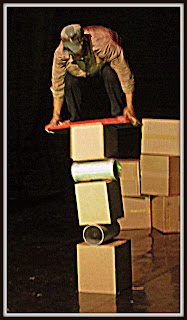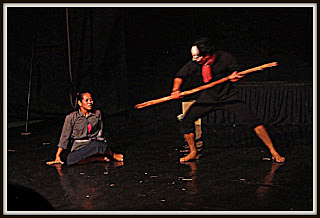The evening of our arrival in Battambang, we had plans to go
see the circus. I hadn’t been to a circus since I was a small child, and my
memories of it involved the stereotypical big tent, three rings, animals,
clowns, jugglers, and maybe a few tumblers thrown in just for fun. I had an
idea that this circus would be different when Jeff pointed out that some of its
former members now are part of Cirque du Soleil.
My thoughts: “Oh, this is going to be more of an acrobatic circus. Cool!”
The show did involve amazing acrobatic feats, and they
indeed were very cool, but it turns out that this circus is even more than that. This circus was Phare PonleuSelpak.
Phare Ponleu Selpak (PPS) is a Non-Governmental Organization
(NGO; often called simply “a charity”) that was started in 1986 in a refugee
camp near the Cambodia-Thai border. From the website: “The idea of a creative
association, which would use art and expression to help young refugees overcome
the trauma of war, emerged from drawing workshops held for children in the
camps. This original idea continued after the refugees returned to their
homeland, and PPS was formally founded in 1994 by a group of former Site 2 [Refugee
Camp] children.” Phare Ponleu Selpak is centered in Battambang and currently
serves over 1,000 children in various ways. Some attend a public school that is
sponsored by the organization; others receive free medical care and meals; and
many have access to a library and leisure center. But those are not the things
for which PPS is most widely known.
PPS is known as a training center for artists, musicians,
actors, and circus performers. During our time on the PPS campus, we
experienced the results of training in all of these areas.
Upon our arrival, we first were ushered into a building in
which original artwork was displayed. The work consisted of pencil drawings as
well as paintings, using a variety of mediums and styles. I so wanted to take
pictures of the art, but that just felt wrong—the work was for sale, and it would
have been too much like stealing to create a digital copy rather than purchase
the original—so I took pictures* only of two huge sculptures that were
displayed in the rafters. These sculptures obviously paid homage to the circus
school, which attracts so many paying visitors to the campus. A friend
purchased small paintings of Buddha faces carved into stone, as well as a set
of paintings of Ta Prohm.
I came close to buying a painting (or two) of traditional, raised Cambodian
houses, and I also gravitated toward one of the Ta Prohm paintings, but I
realized that we purchased so much papyrus in Egypt, and we’ve already
purchased or planned to purchase several other pieces of wall art here, that we
simply won’t have wall space for much more. So I resisted the urge … I’m still
not certain that was the right decision!
After we browsed in the art gallery for a while, it was time
to go to the circus pavilion. This area was a relatively small, open-aired
structure: a flat paved stage, with curtains hiding the backstage areas behind
it, a small musicians’ area beside it, and bleachers in front of it, all
covered by a roof supported by poles, on which hung the necessary spotlights.
Not a particularly impressive setting for what turned out to be a very
impressive show.
Even after learning that the circus is more acrobatic than
animal, my expectations turned out to be too low. I expected spectacular feats,
to be sure, but I expected acrobatics, and that was it—maybe I’m just revealing
that I’ve never seen a Cirque du Soleil show, but it didn’t occur to me that
there was more to it than acrobatics. This was so much more than acrobatics.
This was drama, set to music, accompanied by the creation of original
paintings, and telling the stories both of one woman and of a nation.
The show started with an old woman hobbling out onto the
stage. She was bundled up against the incessant chill that her old bones
probably felt on the warmest of days, wearing glasses, and carrying a book that
she obviously treated with great love and respect. As she sat down to read,
however, she fell asleep … and the story began.
Several young men ran onto the stage, and with loving
tenderness, they began to rewind the clock. Away went the book. Off came the
glasses, then the scarf. With each article that she no longer needed, the woman
straightened, became more energetic … became younger, until at last there was a
young girl sitting there. The girl hopped off the stool and started playing
with her friends, at least until the teacher came in and forced them back to
work.
Meanwhile, off to the side, an artist unobtrusively painted
a serene Buddhist monk, in his bright saffron robes, on a previously blank
canvas.
The show continued
with snippets of the girl’s life. We watched her grow into a young woman, start
dating, have children, become a teacher—each phase marked by exuberant,
awe-inspiring feats of balance and agility by both the girl and those around
her. Along the way, we saw a night when she was tormented by demons—a night
when she almost died, and the serene monk was covered over with black and spattered
with red. A night when her country was ransacked and her life was endangered by
the Khmer Rouge.
We also saw the dawn, when the young woman rose from her
bed, triumphant merely because she still breathed. On canvas, we saw a tranquil
farm on a dirt road—and we saw a city rise in the background, the brown dirt
road transform into the black of asphalt, and street lights appear. We saw
peace and hope return to the country, and to her life.
Eventually, we saw the young woman grow old. We saw her grow
bent and frail. And we saw the tenderness with which her sons treated her as
she released her cares and her frailties and passed on from this life.
We saw this woman’s life story. We laughed at her childhood
antics, we feared for her life, we rejoiced with her when she fell in love. We
shared her pride as she watched her children (or maybe her students) grow and
develop and fulfill their potential. We felt a quiet sadness at her passing,
and yet recognized her satisfaction at a life well lived.
All of this without a word.
That was Phare
Ponleu Selpak.
*None of my pictures turned out very well. Even in the art
gallery, which was well lighted, the rafters were a bit dark. And during the
performance itself, of course it was dark, and flash photography was not
allowed because it could distract the performers. The combination of low light
and quick motion meant that these photos by far are not the best pictures I’ve
ever taken.
**********
**********
Battambang series:








No comments:
Post a Comment
Due to an excess of spam comments lately, I've enabled comment moderation and made it so that you can't comment anonymously--most of the spam comes from Anonymous. However, I love to hear what you think, and I hope you have an account you can use to log in and comment here. Even if we disagree, please leave me a comment. Just keep it family-friendly, please.